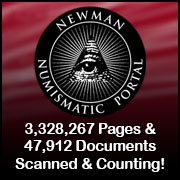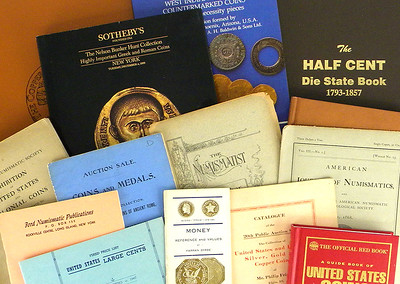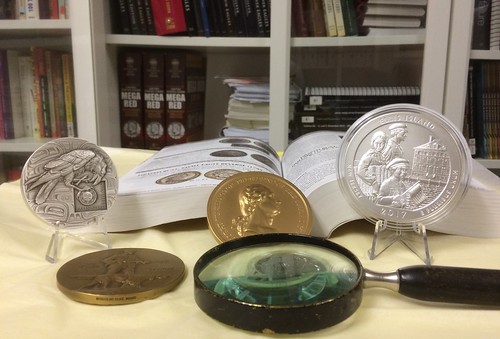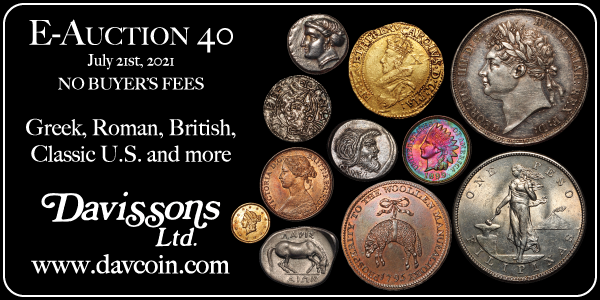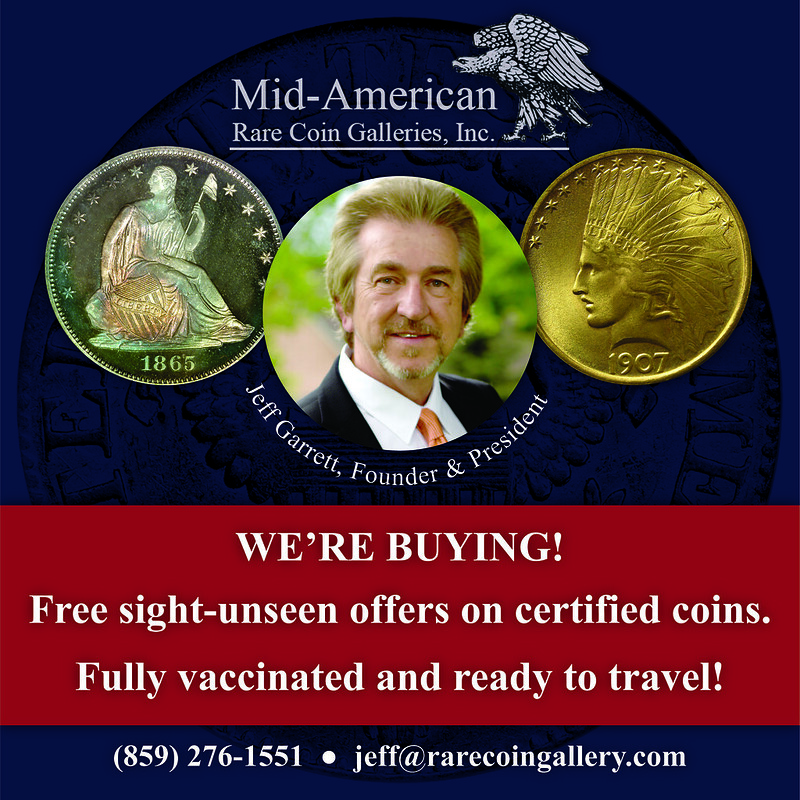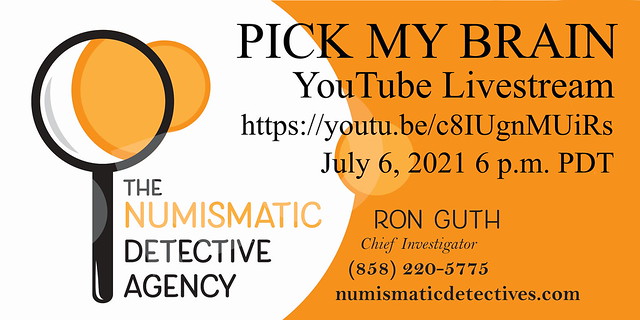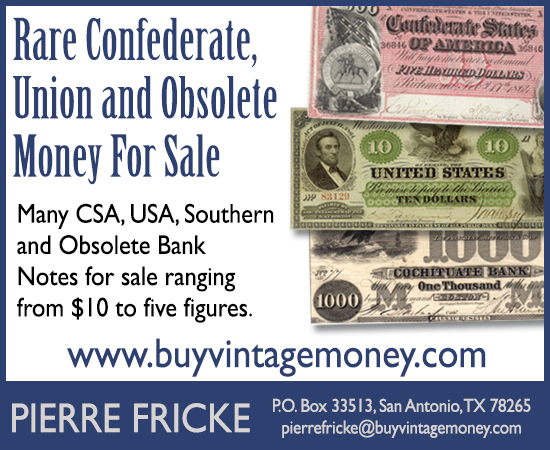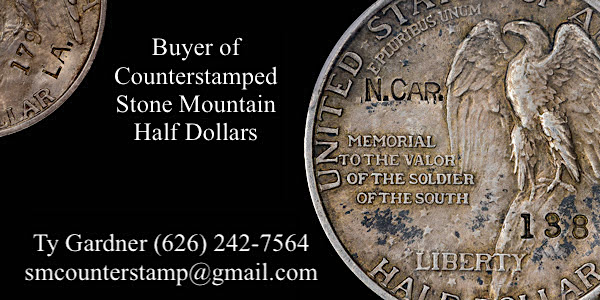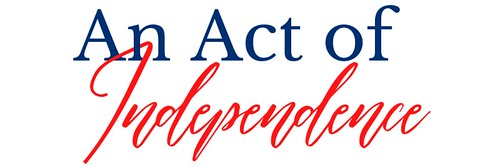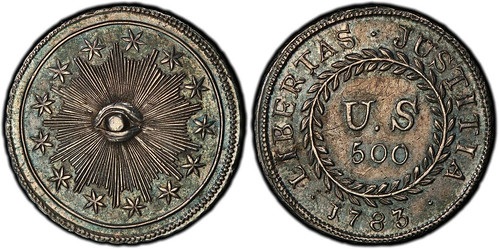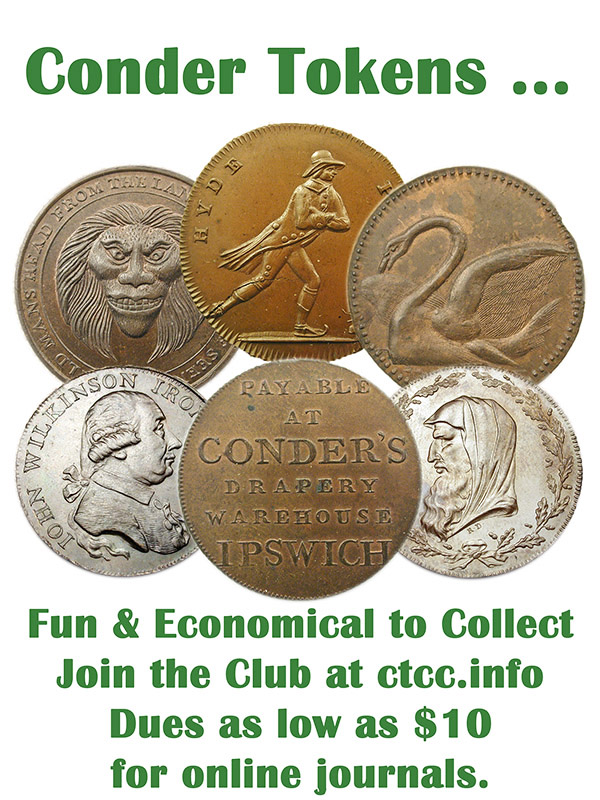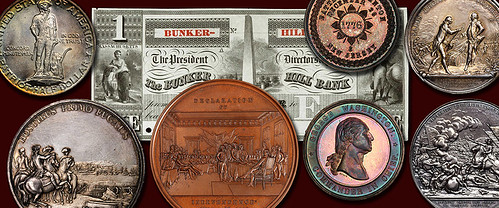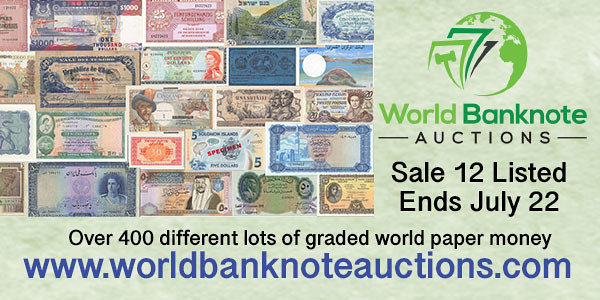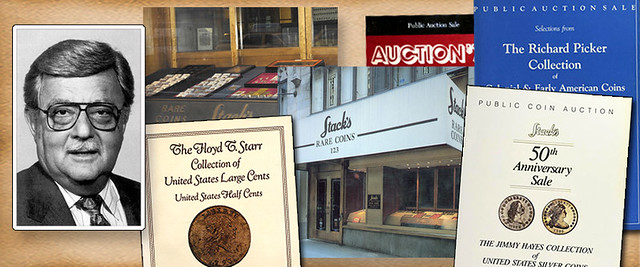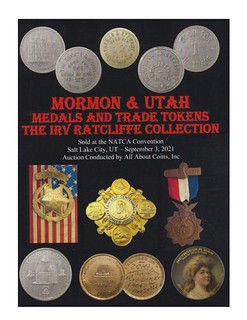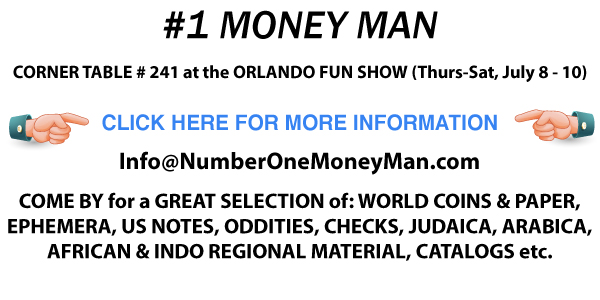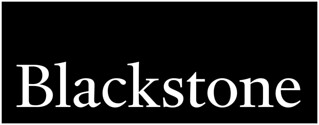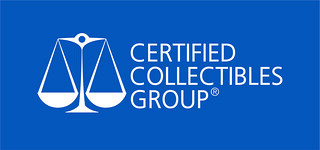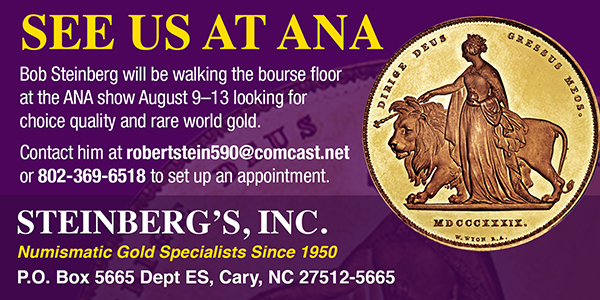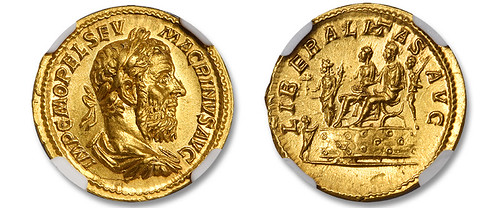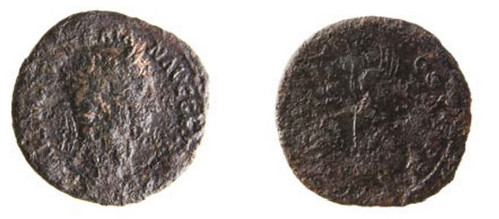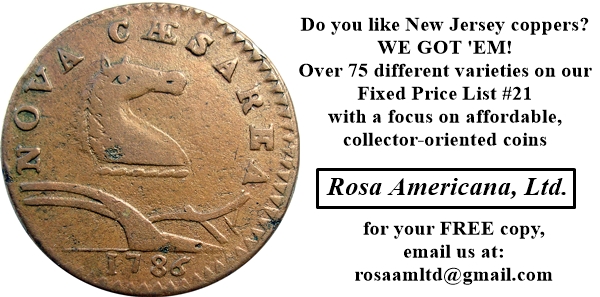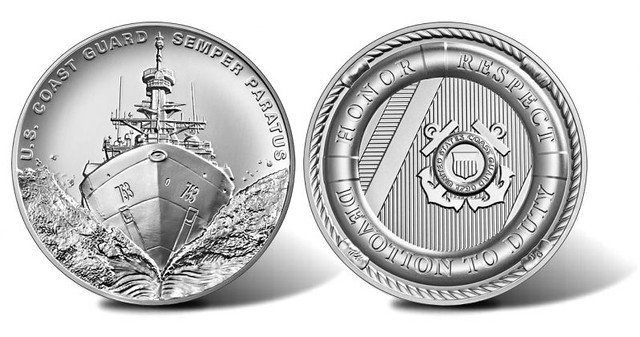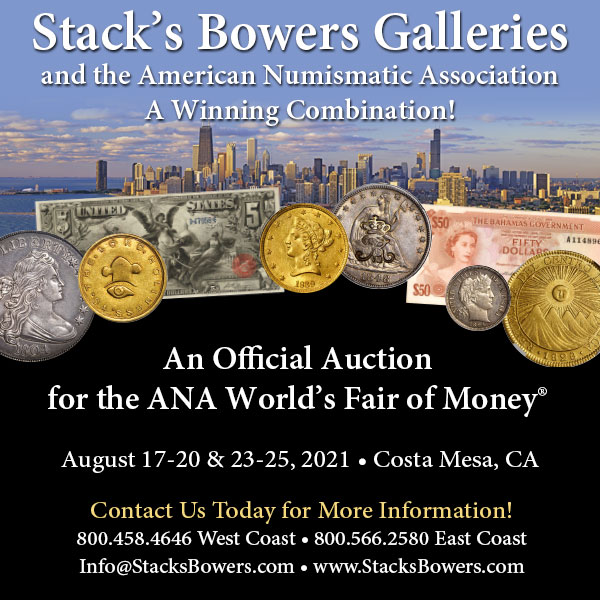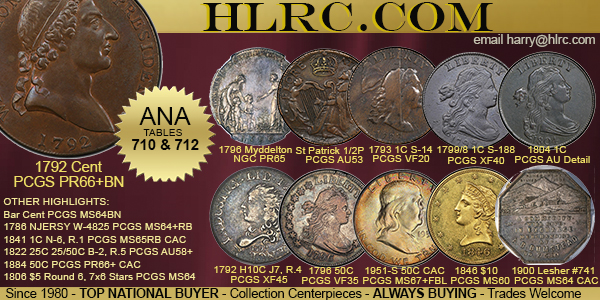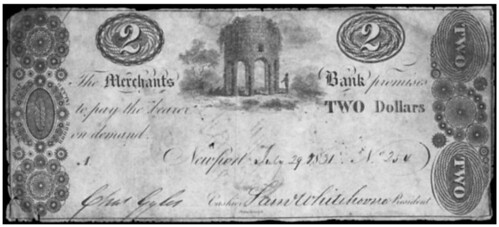
Visit our NBS Sponsors


About UsThe Numismatic Bibliomania Society is a non-profit association devoted to the study and enjoyment of numismatic literature. For more information please see our web site at coinbooks.org SubscriptionsThose wishing to become new E-Sylum subscribers (or wishing to Unsubscribe) can go to the following web page link MembershipThere is a membership application available on the web site Membership Application To join, print the application and return it with your check to the address printed on the application. Print/Digital membership is $40 to addresses in the U.S., and $60 elsewhere. A digital-only membership is available for $25. For those without web access, write to: Charles Heck, Treasurer AsylumFor Asylum mailing address changes and other membership questions, contact Chuck at this email address: treasurer@coinbooks.org SubmissionsTo submit items for publication in The E-Sylum, write to the Editor at this address: whomren@gmail.com BUY THE BOOK BEFORE THE COINSale CalendarWatch here for updates! |
- WAYNE'S WORDS: THE E-SYLUM JULY 4, 2021
- NBS EVENTS AT 2021 ANA WORLD'S FAIR OF MONEY
- SCOTT RUBIN LIBRARY PART TWO HIGHLIGHTS
- NEW BOOK: SIEGE COINS OF THE WORLD 1453-1902
- NEW BOOK: BANKNOTE YEARBOOK 11TH EDITION
- AINA FORUM: ANTIOCH AND JERUSALEM
- PONDERING PANDEMIC PUBLISHING
- NUMISMATIC NOTABLES: KEN BRESSETT
- COINS THAT AREN'T WHAT THEY APPEAR TO BE
- VIDEO: JUDITH KAGIN INTERVIEW
- IAN RANK-BROADLEY STATUE OF PRINCESS DIANA
- NOTES FROM E-SYLUM READERS: JULY 4, 2021
- THE ROBERT S. CHAMBERLAIN COLLECTIONS
- AN ACT OF INDEPENDENCE: THE FIRST U.S. COIN
- REVOLUTIONARY THEMED NUMISMATICS
- BORN ON THE FOURTH OF JULY
- VOCABULARY TERM: ENGRAVING MASTER
- WILLIAM ELLIOT WOODWARD (1825-1892)
- MORE ON THE LAWRENCE BROTHERS
- HARVEY STACK'S NUMISMATIC FAMILY, PART 99
- THE IRV RATCLIFFE MORMON AND UTAH COLLECTION
- NGC PARENT CERTIFIED COLLECTIBLES GROUP SOLD
- NUMISMATIC NUGGETS: JULY 4, 2021
- ROMAN COIN FIND: SAFE CROSSING OFFERINGS
- OLD WELL BENEATH HOME YIELDS OLD COIN
- THE HORROR OF DRUM-POLISHED EIGHT REALES
- U.S. COAST GUARD SILVER MEDAL
- THE LIBERTY DOLLAR IS BACK
- THE MYSTERIOUS NEWPORT TOWER
- THE ART OF STACKING COINS
Click here to read the thin version on the web
Click here to subscribe
Click here to access the complete archive
To comment or submit articles, reply to whomren@gmail.com
Content presented in The E-Sylum is not necessarily researched or independently fact-checked, and views expressed do not necessarily represent those of the Numismatic Bibliomania Society.
WAYNE'S WORDS: THE E-SYLUM JULY 4, 2021
 New subscribers this week include:
Mark Vitunic, courtesy Craig McDonald;
and Kenneth Rasure, who saw us mentioned in the book
New subscribers this week include:
Mark Vitunic, courtesy Craig McDonald;
and Kenneth Rasure, who saw us mentioned in the book The Expert's Guide to Collecting & Investing In Rare Coins
by Q. David Bowers.
Welcome aboard! We now have 6,686 subscribers.
Thank you for reading The E-Sylum. If you enjoy it, please send me the email addresses of friends you think may enjoy it as well and I'll send them a subscription. Contact me at whomren@gmail.com anytime regarding your subscription, or questions, comments or suggestions about our content.
This week we open with NBS events at the ANA convention, numismatic literature sale highlights, two new books, updates from the Newman Numismatic Portal, and more.
Other topics this week include pandemic publishing, coin designer Ian Rank-Broadley, the Robert S. Chamberlain collections, the first U.S. coin, W. E. Woodward, Irv Ratcliffe, Numismatic Nuggets, safe crossing offerings, the U.S. Coast Guard silver medal, and the return of the Liberty Dollar.
To learn more about the Carson City Mint, the scarce first printing of The Fantastic 1804 Dollar, siege coins, the career of Ken Bressett, Yankee Doodle Dandy numismatists, the Jimmy Hayes sales, the sale of Certified Collectibles Group, drum-polished shipwreck coins, and the mysterious Newport Tower, read on. Have a great week, everyone!
Wayne Homren
Editor, The E-Sylum
NBS EVENTS AT 2021 ANA WORLD'S FAIR OF MONEY
NBS President Tom Harrison submitted this note on events at the upcoming ANA convention. Mark your calendars! -Editor
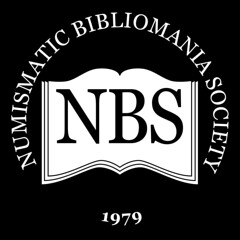 We are excited to once again be attending the ANA World's Fair of Money in person. The Numismatic Bibliomania Society will be hosting club table #724 from Tuesday - Friday. We will be displaying some of the highlights from our all important charity auction that will be held during the General Meeting on Friday. We will also be offering NBS coffee mugs for a $25 donation to the NBS. Please stop by to say hi and share your thoughts about the NBS.
We are excited to once again be attending the ANA World's Fair of Money in person. The Numismatic Bibliomania Society will be hosting club table #724 from Tuesday - Friday. We will be displaying some of the highlights from our all important charity auction that will be held during the General Meeting on Friday. We will also be offering NBS coffee mugs for a $25 donation to the NBS. Please stop by to say hi and share your thoughts about the NBS.
The NBS will be holding our Symposium on Thursday the 12th at 1:00 PM in room 24. The Symposium will feature a presentation by Rusty Goe who is a recognized authority on the history of the Carson City Mint and its coinage. He will be speaking about his three volume set titled The Confident Carson City Coin Collector. The General Meeting will be held on Friday the 13th at 11:30 AM in room 7. The meeting will include the announcement of the awards for the best articles in our print journal, The Asylum and a presentation by NBS Vice President, Len Augsburger discussing the digitalization of Coin World and Numismatic News. Another highlight will be the charity auction that always provides a fascinating variety of literature. The auction is our one annual fund-raiser, so we hope you will join us to help support the mission of the NBS. Looking forward to gathering in Rosemont.
SCOTT RUBIN LIBRARY PART TWO HIGHLIGHTS
Here are some additional highlights from the Kolbe & Fanning sale of Part Two of the P. Scott Rubin Library. -Editor
Kolbe & Fanning Numismatic Booksellers are conducting our mail-bid sale of Part Two of the P. Scott Rubin Library, which closes on Saturday, July 10, 2021. The 923-lot sale features material from the extraordinary library formed over the course of more than fifty years by Scott Rubin, of which highlights were sold in our Sale 157 last year. The auction is being held as a traditional mail-bid sale, for which the catalogue is available as a PDF. The present sale includes not only auction catalogues, but books, periodicals, and archival and ephemeral items. While most of the offerings focus on U.S. coins, a number of items pertain to ancient and world coins, and the sale includes something for everybody.
Some highlights of the sale include:
NEW BOOK: SIEGE COINS OF THE WORLD 1453-1902
My friend Larry Korchnak has collected and studied siege coins since 1972; CNG has published his long-awaited book on the topic. Over 375 coins illustrated in the book are from his personal collection. It will be available after July 8, 2021. With permission, here are excerpts from the book's Foreword and Introduction. Congratulations! -Editor
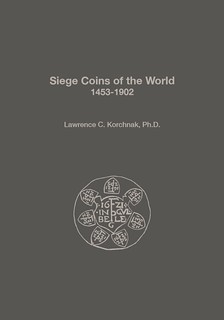 Korchnak, Lawrence C., Ph.D.
Korchnak, Lawrence C., Ph.D.
Siege Coins of the World.
2021.
xii and 318 numbered pp.
Hardbound
$95.00
Website shipping rates do not apply
Introduction
In siege warfare, towns and cities were routinely surrounded by hostile forces and cut off from the outside world. Soldiers battled fiercely for their cause, their lives, and their honor. Historical accounts of the battles between besieger and defender reflect the basest as well as the most sublime aspects of human nature. For example, during one of the sieges of Vienna, the Turks demonstrated their skill in crude psychological warfare by impaling captive Austrians on poles in clear view of defending forces. In contrast, a commanding officer in one Dutch siege exhorted his starving men to hold fast against the Spanish besiegers until help arrived by offering to sacrifice his arm as food.
NEW BOOK: BANKNOTE YEARBOOK 11TH EDITION
Token Publishing has announced the latest edition of the Banknote Yearbook. A digital version is available as well. -Editor
Banknote Yearbook 11th edition
£29.95
Release Date: Mon, 26 July 2021
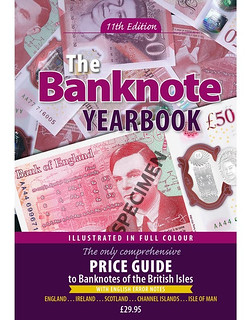 PRE-ORDER YOUR COPY TODAY! After a long coronavirus enforced delay the BRAND NEW 11th edition of the BANKNOTE YEARBOOK will be available very soon! At an impressive 568 pages this hardbound book is the perfect reference for all collectors of English, Scottish, Irish and Island banknotes with all the notes of the main banks (and the early Treasury notes) covered and illustrated in full colour. It includes a full price guide for all notes (most in three grades) and has been fully update in line with market movements. It also contains all the new issue notes from the past four years right up to, and including, the new polymer
PRE-ORDER YOUR COPY TODAY! After a long coronavirus enforced delay the BRAND NEW 11th edition of the BANKNOTE YEARBOOK will be available very soon! At an impressive 568 pages this hardbound book is the perfect reference for all collectors of English, Scottish, Irish and Island banknotes with all the notes of the main banks (and the early Treasury notes) covered and illustrated in full colour. It includes a full price guide for all notes (most in three grades) and has been fully update in line with market movements. It also contains all the new issue notes from the past four years right up to, and including, the new polymer Turing
£50 which features on the front cover. Retailing at £29.95 (plus p&p) the book is a must have for collectors; with the 10th edition having completely sold out this one has been very eagerly awaited – order your copy today and get it POST FREE (if ordered before July 30)
AINA FORUM: ANTIOCH AND JERUSALEM
Readers are invited to an AINA Forum featuring author Dr. David Jacobson. Here's the announcement. -Editor
Antioch and Jerusalem, the Seleucids and Maccabees in Coins
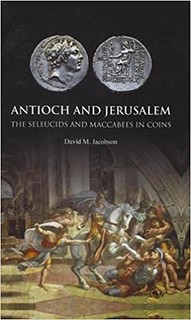 The next AINA (American Israel Numismatic Association) forum will feature Dr. David Jacobson, Associate of the Faculty of Oriental Studies Faculty, University of Oxford, and winner of AINA's 2021 Shekel Prize Medal. The forum will be held jointly with the Anglo-Israel Archaeological Society. Jacobson's talk will be about
The next AINA (American Israel Numismatic Association) forum will feature Dr. David Jacobson, Associate of the Faculty of Oriental Studies Faculty, University of Oxford, and winner of AINA's 2021 Shekel Prize Medal. The forum will be held jointly with the Anglo-Israel Archaeological Society. Jacobson's talk will be about Antioch and Jerusalem, the Seleucids and Maccabees in Coins,
the subject of his book with the same title. The zoom talk will take place on August 22 at 7 PM in England, corresponding to 2 PM EST, 11 AM PST, and 9 PM in Israel. To receive an invitation, email Simcha Kuritzky, President of AINA, at
amerisraelcoin@gmail.com.
Jacobson's work recounts the heroic story of the Maccabees and explains how they successfully took on the might of the Seleucid realm, illustrated by the coins issued by the main protagonists. The author writes: What was an epic struggle of an oppressed people to win their national and religious freedom has provided much inspiration through the ages and continues to strike a strong resonance in our own times. However, the historical drama, as recorded in 1 and 2 Maccabees, with its unfamiliar roll-call of major players and place names, has acquired a considerable mystique. The coins put faces to many of these seemingly obscure names and help bring those stirring events back to life.
PONDERING PANDEMIC PUBLISHING
In his latest CoinUpdate Notes Published column, Dennis Tucker of Whitman Publishing ponders pandemic-produced publications in the numismatic world. -Editor
The Pandemic, and Writing Time
In recent months I've heard from many numismatists who tell me they've used the past year-plus of involuntary isolation to buckle down and catch up on research and writing.
Last week I talked with one writer about a project we first discussed eight years ago; he's been tinkering with it over the years but is now working in earnest. (He wasn't asleep at the wheel; he's been active and publishing in other areas in the meantime.)
NUMISMATIC NOTABLES: KEN BRESSETT
The latest addition to the Newman Numismatic Portal is a video interview with Ken Bressett. Project Coordinator Len Augsburger provided the following report. Thanks! -Editor
Numismatic Notables: Ken Bressett
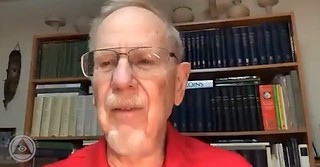 In honor of July 4, one of Ken Bressett's favorite holidays, Newman Portal announces the second installment in its Numismatic Notables series. Bressett was interviewed by Len Augsburger and Joel Orosz on March 19, 2021 and this video is now available on Newman Portal. Bressett covers his early days as a collector, his extensive photo archive that he started in the 1940s, and his first contacts with Richard Yeoman, Guide Book of United States Coins founder.
In honor of July 4, one of Ken Bressett's favorite holidays, Newman Portal announces the second installment in its Numismatic Notables series. Bressett was interviewed by Len Augsburger and Joel Orosz on March 19, 2021 and this video is now available on Newman Portal. Bressett covers his early days as a collector, his extensive photo archive that he started in the 1940s, and his first contacts with Richard Yeoman, Guide Book of United States Coins founder.
Bressett began submitting edits to the Guide Book in the 1950s and was soon hired by Whitman Publishing on a full-time basis. Later, Bressett worked for the American Numismatic Association in a variety of capacities. He continues today as Guide Book Editor Emeritus. This interview covers little-known aspects of Bressett's career, including a number of important coins he handled from the Anderson DuPont collection. Bressett further summarizes important changes in the coin industry since his beginnings as a collector in the 1930s. With video production by Lianna Spurrier, this is a pleasant hour well-spent.
Link to Numismatic Notables: Ken Bressett on Newman Portal:
https://nnp.wustl.edu/library/book/601239
COINS THAT AREN'T WHAT THEY APPEAR TO BE
Newman Numismatic Portal intern Garrett Ziss provided the following article based on recently added digital content. Thanks! -Editor
Last week's NNP E-Sylum article highlighted inquiries to the U.S. Mint that included pencil rubbings of Early United States coins. Three additional letters from the National Archives also contain pencil rubbings of numismatic items. Even though they are quite different from each other, they all fall under the category of Not What They First Appear To Be.
The fact that their identities are a bit unusual likely prompted their owners to seek help from the Mint.
VIDEO: JUDITH KAGIN INTERVIEW
These are selections from the David Lisot Video Library that feature news and personalities from the world of coin collecting. David has been attending coin conventions since 1972 and began videotaping in 1985. The Newman Numismatic Portal now lists all David's videos on their website at:
https://nnp.wustl.edu/library/multimediadetail/522852
Here's an interview with dealer Judy Kagin. -Editor
Judy Kagin Continues Family Tradition in Numismatics with Paper Money.
VIDEO: 9:49.
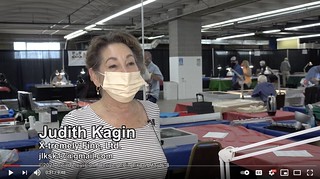 Judith Kagin, Owner, X-tremely Fine, Ltd,
Judith Kagin, Owner, X-tremely Fine, Ltd,
David Lisot, Interviewer, CoinTelevision.com.
May 6-8, 2021.
Judy Kagin's father was A.M. Art
Kagin, one of the greatest numismatists of all time. Judy became interested in paper money and embarked on a career in the coin industry buying and selling some of the most beautiful notes ever made in the United States. She shares the story of her life and tales of some of her favorite bank notes.
An excerpt of the video is available for viewing on the Coin Television YouTube Channel at:
https://youtu.be/29dkpJOrD48
IAN RANK-BROADLEY STATUE OF PRINCESS DIANA
David Pickup writes:
"There are several stories in the press about the sculptor of the statue of Diana Princess of Wales on internet. He is also a coin designer. In 1997 he won the Royal Mint competition for a new effigy of Elizabeth II to appear on the obverse of circulated British and some Commonwealth coinage. He also designed the Queen Mother Centennial crown coin and the portrait of Elizabeth II and Prince Philip on the 2007 crown coin, celebrating their sixtieth wedding anniversary.
"The statue of Diana, unveiled on Friday, has had a mixed reception. His Armed Forces Memorial at the National Memorial Arboretum containing two large figure groups, comprising fourteen figures, each one and a quarter times life size is a powerful and dramatic piece of art earning him the 2008 Marsh Award for Excellence in Public Sculpture."
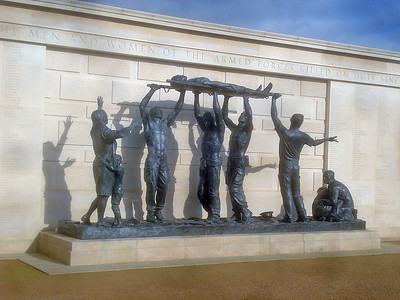
https://commons.wikimedia.org/wiki/File:Statue_at_the_Armed_Forces_Memorial_-_geograph.org.uk_-_1566956.jpg
Thanks. I located a couple articles with more information. The new statue features three children, but one is obscured by the angle of many of the photos taken of it from the front. Here's one picturing the sculptor and his work from a better angle. -Editor
NOTES FROM E-SYLUM READERS: JULY 4, 2021
Quiz Answer: What's Wrong With These Coins?Paul Horner writes:
"Regarding the US Mint & Coinage cover; Whew, These are pretty bad!
1. Lincoln Cents do not have a ring of dots around the edge on either side.
2. Kennedy half dollars do not have a ring of dots either, and genuine K. Halves have reeded edges, not plain.
3. The gold American Eagle does not have a ring of dots, it does have a ring of stars. The real gold American Eagles have a reeded edges. If it it supposed to be a double eagle, it should have stars not dots and a lettered edge."
Dave Lange writes:
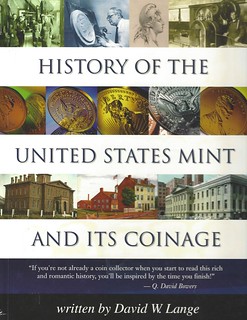 "I had to chuckle when I saw Bruce Bartelt's piece about my mint history book. Needless to say, I had no input into the cover design, which is entirely the product of Whitman's art department. I suspect those "coins" in the second row of illustrations may contain chocolate. I've told the story of this book's creation before, and it's been in The E-Sylum already, but I'll include a brief recap here.
"I had to chuckle when I saw Bruce Bartelt's piece about my mint history book. Needless to say, I had no input into the cover design, which is entirely the product of Whitman's art department. I suspect those "coins" in the second row of illustrations may contain chocolate. I've told the story of this book's creation before, and it's been in The E-Sylum already, but I'll include a brief recap here.
"It began as a correspondence course commissioned of me in 1995 or 1996 by the ANA's then education director, James Taylor. The history portion I wrote was to be combined with a section on current minting technology to be written by the late J. T. Stanton. For whatever reason, J. T. never delivered his chapters, and the whole project was abandoned when James left the ANA after being passed over for the executive director position. My manuscript was discovered a few years later by his successor, Gail Baker, who revived the project. The folks at the ANA liked it enough that I was asked to bring it up to date and add a few chapters so that it could be published by the ANA as a book rather than a correspondence course. A graphic designer who had done previous work for the ANA, Mary Jo Meade, was assigned to select images and put the whole thing together. Rudy Bahr of the ANA's staff would oversee its publication.
"The project was nearing completion when the ANA's executive director, Chris Cipoletti, purged a slew of people, Rudy included. At some point he struck a deal with Whitman Publishing to put out the book commercially. I heard about this only indirectly, as I was entirely out of the loop at that point. I first learned it was in print when I saw it for sale at the Whitman booth during a 2005 coin show. It came complete with a greeting from Cipoletti dated April of that year and titled "Discover and Explore the World of Money." The cover design was startling to me, but naturally I bought a copy of the book to inspect the finished product. I discovered a number of minor errors, mostly pertaining to the images, but otherwise it looked pretty good.
"After Chris Cipoletti's employment was terminated by the ANA a couple years later, a new printing was issued without his two pages. The graphic errors were fixed at the same time, though I don't believe this revised printing was labeled a second edition. The book soon became my best selling title, but I have no financial interest in it whatsoever. I had written it pro-bono on behalf of the ANA and have never sought compensation. I don't know how much was remitted to the ANA, but I imagine it must have benefitted in some way."
Interesting. I had no idea there was more than one version of the book. For grins, I'll keep my eye open for the other variant. -Editor
To read the earlier E-Sylum article, see:
NOTES FROM E-SYLUM READERS: JUNE 27, 2021 : Quiz Quiz: What's Wrong With These Coins?
(https://www.coinbooks.org/v24/esylum_v24n26a17.html)
Other topics this week include unfolding coins, Couroc coin plates, the Emil Justh sale, and an S.B. Colby image. -Editor
THE ROBERT S. CHAMBERLAIN COLLECTIONS
Scott Miller writes:
"Many medal collectors are familiar with the work of Georgia Stamm Chamberlain, but few realize that her husband, Robert S. Chamberlain also collected coins and medals. The collection can be found at the University of South Carolina. I recently came across a brief catalogue from the University of South Carolina Libraries."
Thanks! I wasn't aware of this. Here's an excerpt from the collection summary document. -Editor
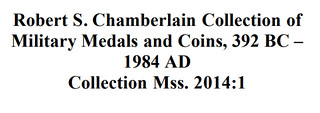 The Robert S. Chamberlain Collection of Military Medals and Coins contains
military medals, Greek and Roman coins, Civil War documents, and military figurines collected by the Latin American historian Robert Chamberlain (1903-1981), mostly during the late 1960s and 1970s. The collection also documents Chamberlain's research in Hispanic American history during the colonial period and railroads.
The Robert S. Chamberlain Collection of Military Medals and Coins contains
military medals, Greek and Roman coins, Civil War documents, and military figurines collected by the Latin American historian Robert Chamberlain (1903-1981), mostly during the late 1960s and 1970s. The collection also documents Chamberlain's research in Hispanic American history during the colonial period and railroads.
Robert Stoner Chamberlain was born in Canton, Ohio, on October 13, 1903. He received a B.A. in History from Stanford University in 1925, a B.S. in Education from Ohio State University in 1927, and a Ph.D. in History from Harvard University in 1936. He was a staff member in the Division of Historical Research at the Carnegie Institution in Washington, D.C. from 1936-1947. During the war years, he served as a cultural relations officer at the United States embassy in Guatemala City. He was an Associate Professor of History at the University of Miami, 1947-1948, and was in government service from 1948 until his retirement in 1965. His primary academic interest was Hispanic America during the colonial period. After retirement, he pursued his interests in Civil War history, collecting medals and coins, and doing some research on American railroads and trains.
AN ACT OF INDEPENDENCE: THE FIRST U.S. COIN
David McCarthy published an article in the May 2021 issue of The Numismatist about his discovery that within hours of receiving the news that the Revolutionary War had been won, the United States ordered its first coin to be struck. -Editor
On Sunday, March 23, 1783, a French naval cutter made its way up the Delaware River, dropping anchor south of Independence Hall in Philadelphia. The aptly named Le Triomphe had set sail from Cadiz 36 days earlier, carrying news that Great Britain recognized the sovereignty of the United States. American independence had become a reality.
REVOLUTIONARY THEMED NUMISMATICS
Unfortunately, the only images in this article are within the montage at the top, but it describes a number of great numismatic items associated with American independence. Happy 4th of July! From an unnamed author on the Stack's Bowers blog. -Editor
Independence Day is upon us once again. In this week's blog, we are going to take a look at a few major battles of the Revolutionary War and the medals, currency and coins that commemorate them.
THE BOOK BAZARRE
BORN ON THE FOURTH OF JULY
I'm no Yankee Doodle Dandy myself, but Happy Birthday to all those who are. Pete Smith submitted this list of numismatists born on the Fourth of July. Thanks! -Editor
These people, associated with numismatics, were born on the Fourth of July.
William Cutler Atwater was born on July 4, 1861. He was in the coal business. His collection included some choice rarities like a Brasher Doubloon and the Stickney 1804 dollar.
Shawn Duthie was born on July 4, 1964. He was named ANA Young Numismatist of the Year in 1982.
George Nicholas Eckert was born on July 4, 1802. He served as Director of the Mint 1851 to 1853.
Roland W. Finner Rollie
was born on July 4, 1934. He was the voice of public announcements at the
message center for Central States and ANA shows.
Frank Van Zandt was born on July 4, 1949. He served as Secretary-Treasurer of the Numismatic Bibliomania Society.
Are there others who should be included on this list?
VOCABULARY TERM: ENGRAVING MASTER
Here's another entry from Dick Johnson's Encyclopedia of Coin and Medal Terminology, describing a likely obsolete yet still interesting part of the traditional engraving process - the engraving master. -Editor
Engraving Master. A metal pattern usually made by acid etching which serves as a template for engraving a design a metal object as a medal or plate by a pantographically on controlled surface engraving machine (see Gorton). An engraving master is required for a design other than letters (which can be engraved from stock template letters) – including monograms, signatures, logos and other nonletter designs. Engraving masters are made of metal, as copper, or any hard etchable material, even some plastics. The design is usually oversize, having been pantographically enlarged from original copy, it is incuse design as the channel in the master is what guides the tracer point to effect the engraving.
WILLIAM ELLIOT WOODWARD (1825-1892)
Here's another entry from the online draft of John Lupia's book of numismatic biographies. Thanks! This is an excerpt with the full article and bibliography available online. This week's subject is dealer W. E. Woodward. I added an auction cover image. -Editor
Woodward, William Elliot (1825-1892), He was born October 29, 1825 in Oxford, Maine, son of Captain Caleb Woodward and his second wife, Hannah Cary. During his early career he lived in Middletown, Connecticut, 16 miles south of Hartford where he was engaged in the insurance business. He married Clarissa Eliza Roys on June 26, 1848 while in Norfolk, Connecticut. That same year he moved opening the Mount Pleasant Apothecary Shop at 258-260 Dudley St. corner of Dearborn, Roxbury, Boston Highlands, Massachusetts. A pharmacist by trade he began collecting coins and other curios early on.
In 1851 they had a son born on April 12th whom they named Harlow Elliot Woodward. September 1856 they had a second son, Clarence Elliot Woodward. On February 3, 1858, W. Elliot Woodward became a member of the New England Historic Genealogical Society. Their third child Claribel only lived about 12 to 18 months and was buried on July 22, 1861.
MORE ON THE LAWRENCE BROTHERS
Pete Smith writes:
"The Lawrence Brothers were mentioned in recent issues of The E-Sylum. I dug through my files and found some related items."
Thanks! -Editor
HARVEY STACK'S NUMISMATIC FAMILY, PART 99
The latest article in Harvey Stack's blog series wraps up the year 1985, including the Jimmy Hayes sale. -Editor
In September 1985, Stack's auctioned 1,954 lots of very interesting coins from a variety of popular series. It provided a great chance for collectors to fill in the gaps.
Whether it was type coins from half cents to double eagles, Proof sets, or rolls of coins, one could find them in this comprehensive sale. It was a typical sale for Stack's at the time, with consignments from a number of fine collectors, most of whom used our sales to gather funds for new purchases, to complete a collection or start a new series. This made our typical
sales very popular with both bidders and consignors.
And then, we moved into the 50th Anniversary Sale, a major offering and a great celebration. It took place over three days in October; there were three catalogs and each had its own focus. One had only 128 lots, all rare U.S. silver type coins from the Jimmy Hayes Collection. The second catalog offered coins from the Bartle Collection and the Carl Zelson Collection, 758 lots of choice and rare U.S. coins. The third and last catalog presented the Zurich Collection of Foreign Gold & Silver and English Gold & Silver Coins, 780 lots in total. Each session contained coins that were in great demand, attracting collectors and dealers from all over. The auction room was filled from start to finish and the prices realized reflected the importance of the event.
THE IRV RATCLIFFE MORMON AND UTAH COLLECTION
Bob Campbell's All About Coins Inc, will be selling the Irv Ratcliffe collection of Mormon and Utah medals and trade tokens at the September 3, 2021 NATCA convention in Salt Lake City. With permission, here's an article about Irv from the July 2021 issue of The Mint Master from the Utah Numismatic Society. -Editor
Irvin Hale Ratcliffe was born in 1930 in Roanoke, Virginia. As the third of eleven children he learned to work hard at an early age. When he was ten years old, one of his chores included walking some distance to a neighbor's house to buy milk. His mother would provide him with Indian Head Pennies, Buffalo Nickels, and the occasional Standing Liberty Quarter. Irv was fascinated with these older coins.
Money was very tight at the Ratcliffe farm. but on rare occasions his mother would give him an old well-worn coin. lrv treasured these coins and the special bond with his mother, and it was at this young age that his interest in collecting started. However, Irv did comment that as a youth his collection was always safe until summer arrived and the ice cream man came by the farm.
NGC PARENT CERTIFIED COLLECTIBLES GROUP SOLD
I'm sure everyone reading this issue has already heard this news, but I thought I'd be remiss in not including it given all of our past discussion on the rise of sports card collecting and the recent purchase of PCGS parent Collectors Universe. Here's Thursday's press release from PCGS rival Certified Collectibles Group, parent of NGC - they've been purchased by another Wall Street investment firm. -Editor
Blackstone (NYSE:BX) announced today that funds managed
by its Tactical Opportunities business (Blackstone
) have agreed to acquire a majority stake in the
Certified Collectibles Group (CCG
) in a transaction valuing the company at more than $500 million.
Mark Salzberg, CCG's founder, and Steven R. Eichenbaum, CCG's CEO, will retain a significant
minority stake. Additional investors in today's transaction include Roc Nation; Michael Rubin, founder
and executive chairman of Fanatics; SC.Holdings, a growth equity platform; Mastry, founded by Rudy
Cline-Thomas; Andre Iguodala; Daryl Morey, President of Basketball Operations for the Philadelphia
76ers; and Main Street Advisors, a leading investment advisory firm to prominent athletes, recording
artists, and other leaders across entertainment and business.
NUMISMATIC NUGGETS: JULY 4, 2021
Here's a selection of interesting or unusual items I came across in the marketplace this week. Tell us what you think of some of these. -Editor
Our upcoming Official Auction of the ANA World's Fair of Money will present a tremendous array of stunning ancient coins emanating from various well-cultivated collections. A standout among them is a dazzling and lustrous gold aureus of Roman emperor Macrinus, who reigned briefly in A.D. 217-218 during a chaotic time in Rome's history. This stunning example, quite likely the finest of the type—or of any gold issue for the emperor—presents an exacting, razor-sharp strike that is so well centered that the beading of the borders on each side is wholly contained upon the flan.
This piece is in the upcoming Stacks Bowers auction. It was discussed in a blog article by Senior Numismatist and Cataloger Jeremy Bostwick. -Editor
To read the complete article, see:
Stunning Aureus of Macrinus – A Connoisseur's Dream
(https://www.stacksbowers.com/News/Pages/Blogs.aspx?ArticleID=choice-ms-aureus-of-macrinus-stacks-bowers-galleries-august-showcase-auction)
Other topics this week include an Atlantic & Ohio Telegraph Co. Counterstamp, and encased postage stamps and postage stamp envelopes. -Editor
ROMAN COIN FIND: SAFE CROSSING OFFERINGS
The University of Leiden published an article about an interesting find of Roman coins believed to be offerings for the safe crossing of a river. -Editor
Several years ago, two amateur archaeologists from Brabant discovered over a hundred Roman coins near to Berlicum in the north of the province. After years of research, it now appears that the location, close to a ford in the river, was a site for offerings. Another interesting fact is that the coins offered were chosen very precisely. ‘This was an important eureka moment in my academic career.'
THE BOOK BAZARRE
OLD WELL BENEATH HOME YIELDS OLD COIN
This Daily Mail story passed along by Erik Goldstein is more interesting for where an old coin was found than the coin itself. Thanks. -Editor
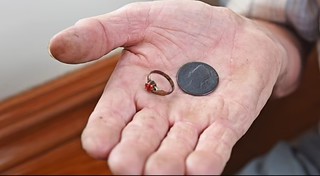 A grandfather who spent the last decade digging out a 17ft-deep medieval well in his living room floor has found a coin from 1725.
A grandfather who spent the last decade digging out a 17ft-deep medieval well in his living room floor has found a coin from 1725.
Colin Steer, 70, discovered the well after he noticed a dip in the floor of the living room in his Victorian home in Plymouth, Devon, while redecorating 34 years ago.
At the time he had three small children running around so his wife Vanessa asked him to cover it back up, but when he retired in 2012 he took it on as a project and started digging.
THE HORROR OF DRUM-POLISHED EIGHT REALES
Gary Beals submitted this article on a thankfully obsolete method of cleaning shipwreck coins. Thanks! -Editor
Oh, the horror —
The 1970s and 1980s — when 8 reales coins recovered
from 1622 wrecks were drum-polished to a high sheen!
A 1986 National Geographic television documentary shows recovered coins being tumbled in a pebble polishing drum accompanied by chemicals and hundreds of ball bearings. The sound on the documentary of those rare Spanish colonial coins and ¼-inch stainless steel ball bearings being tumbled is terrorizing to any serious coin lover. And to think that those coins may have spent hours in this metal drum being battered against its sides, with steel balls is a nightmare. As the camera zoomed in, the voice-over noted that the pieces were gleamingly shiny — just what the salvors wanted. There are still shots captured from the program:
U.S. COAST GUARD SILVER MEDAL
Mike Unser wrote an article for CoinNews.net on the new U.S. Coast Guard 2.5 Ounce Silver Medal. Great looking piece! Congrats to the designers and engravers. Great team effort. -Editor
The United States Mint this week unveiled design information and images for its 99.9% fine U.S. Coast Guard 2.5 Ounce Silver Medal which will feature a diameter of 2 inches.
Scheduled to launch Aug. 16, the product is the second of five from the U.S. Mint's Armed Forces Silver Medal Program. The first medal honors the Air Force. It will be available July 13. Forthcoming medals will celebrate the Navy, Marine Corps and Army. The Mint will also later issue bronze versions as well as smaller 1-ounce silver editions.
THE LIBERTY DOLLAR IS BACK
This press release published Thursday announces the return of the Liberty Dollar. -Editor
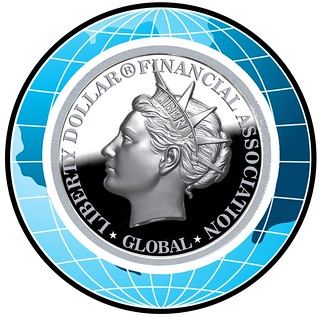 Are you concerned about the US government's announcement that it has suspended minting of some silver coins because of the silver shortage? This news was devastating for many who consider silver to be a safe hedge against inflation, but a new startup is ready to ease the shock.
Are you concerned about the US government's announcement that it has suspended minting of some silver coins because of the silver shortage? This news was devastating for many who consider silver to be a safe hedge against inflation, but a new startup is ready to ease the shock.
Liberty Dollar Financial Association (LDFA) offers its members the ability to purchase a small portion of large-block stored silver that is normally unavailable to most people. Members can monitor their accounts online and convert their silver back to US dollars at the current silver price at any time, usually within minutes, 24 hours a day. A debit card is also in the works that will provide members access to their money instantly worldwide, and Merchants can use LDFA for payment processing anywhere online or with our upcoming smartphone app for Point-Of-Sale transactions.
THE MYSTERIOUS NEWPORT TOWER
The New England Numismatic Association's official publication is NENA News. John Ferreri offered to share some articles with E-Sylum readers. Here's a token article that caught my eye - it's from the March 2021 issue by John himself, on the mysterious tower seen on Rhode Island paper money. Thanks! -Editor
This 1831 $2 note of the Merchant's Bank of Newport shows the mysterious tower in Truro Park in the city of Newport, RI. This was built on hilly land at one time owned by Benedict Arnold, the great-grandfather of the Benedict of Revolutionary War fame and disgrace. Notice the amount of intrusive brush that flows over the stone sides, indicating that even in 1831, the date of the engraving, this structure must have been quite old. The fact that it still stands is a testament to the workmanship involved when it originally was built. The note was engraved by Peter Maverick an outstanding banknote engraver of his day and will show the uncluttered and precise qualities of his work.
THE ART OF STACKING COINS
We've discussed this topic in the past - coin stacking. Len Augsburger forwarded an article with some great photos of creative coin stacks. -Editor
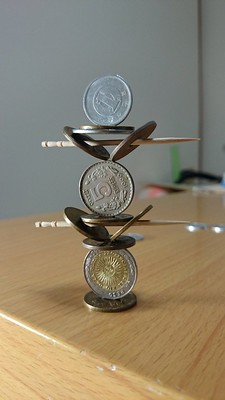 Japanese Twitter user @thumb_tani (aka Tanu) has mastered the art of balance. He uses his keen sense of equilibrium to create small, fascinating sculptures from carefully-positioned coins. Although many of us have probably attempted this same sort of coin stacking, Tanu takes these arrangements to a whole new—and totally epic—level.
Japanese Twitter user @thumb_tani (aka Tanu) has mastered the art of balance. He uses his keen sense of equilibrium to create small, fascinating sculptures from carefully-positioned coins. Although many of us have probably attempted this same sort of coin stacking, Tanu takes these arrangements to a whole new—and totally epic—level.
Using a variety of denominations, Tanu creates intricate structures that range in shape and size. Often, he'll first build a strong base using staggered coins. Then, he does the seemingly impossible. Tanu stands the coins upright and places them edge-to-edge without the discs falling or even wobbling. From there, he'll sometimes stack even more coins (or other objects) on top. It's a mesmerizing sight, but also one that you'll want to hold your breath for. The precarious sculptures look as though they could tumble at any moment.
To read the complete article, see:
Japanese Man Masters the Gravity-Defying Art of Stacking Coins
(https://mymodernmet.com/thumb-tani-tanu-japanese-coin-stacking/)
To read the earlier E-Sylum article, see:
AMAZING COIN STACKING VIDEOS
(https://www.coinbooks.org/esylum_v19n50a36.html)
MORE AMAZING COIN STACKS
(https://www.coinbooks.org/esylum_v19n51a35.html)

